Porto-North-Portugal.com
The best independent guide to Porto
Porto-North-Portugal.com
The best independent guide to Porto
Porto Weather: The Best Time of Year to Visit
Porto’s weather is defined by four distinct seasons, each creating a unique travel experience. Summers are glorious and sun-drenched, drawing the largest crowds and filling the city with a vibrant energy. The shoulder seasons of spring and autumn provide the best balance, with wonderfully pleasant weather ideal for exploring. Winters, though mild, are notoriously wet, offering a quieter trip for visitors prepared for rain.
For many, the ideal time to explore Porto is during late spring (May to June) and early autumn (September). During these months, the city is bathed in warm sunshine, but the summer crowds have yet to arrive or have already departed. This creates a perfect balance, allowing you to enjoy sightseeing in comfortable conditions, with more competitive prices for flights and accommodation.
The peak season of July and August sees Porto at its most lively and hottest. This is a time for leisurely paced sightseeing or a beach-focused holiday along the beautiful Costa Verde. Porto is one of Portugal’s finest areas to visit in the summer, with fewer crowds than Lisbon and calmer beaches than the Algarve.
In contrast, the winter months (November to March) constitute the low season. This period is characterised by unpredictable and often very wet weather. It’s worth noting that this rain can persist into late April, just as the main tourist season begins to stir.
This detailed guide breaks down the weather, events, and atmosphere of each season to help you plan the perfect trip to Porto.
The weather of Porto
The following charts provide the data on Porto's climate, but understanding the nuances is key to planning your trip.
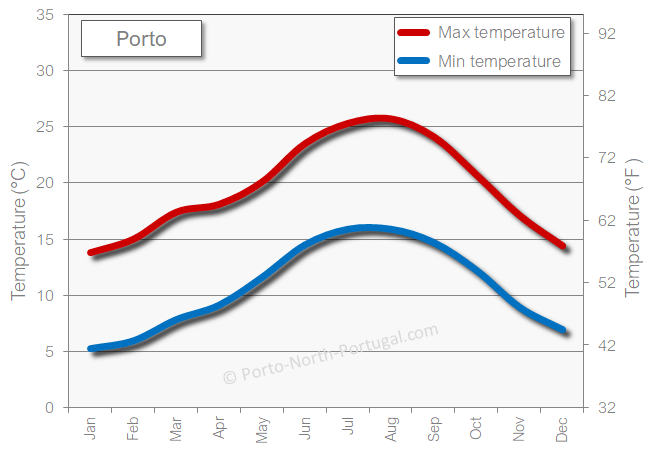
During summer, daytime temperatures routinely exceed 25°C (77°F). As this is the average air temperature measured in the shade, it will feel considerably hotter while sightseeing under the intense summer sun.
Porto provides ample sunshine in summer, with an average of 9.9 hours per day. This is comparable to Lisbon (11.4 hours) and the Algarve (11.9 hours). In winter, the average drops to 4.0 hours of sunshine per day, but this is still a significant improvement over Northern European cities like London or Paris (both 1.6 hours).
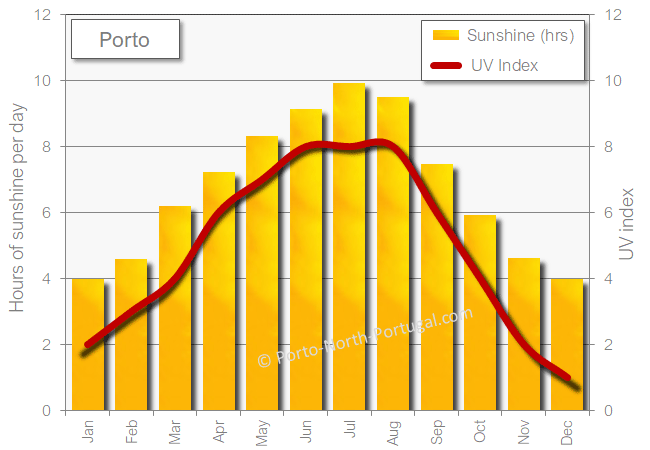
Surprisingly, Porto is one of the wettest cities in southern Europe, and this high annual precipitation falls mostly in the winter months. Between October and April, over half of all days will see some rain, and in deep winter, six days per month will experience very heavy rain with 10mm or more falling.
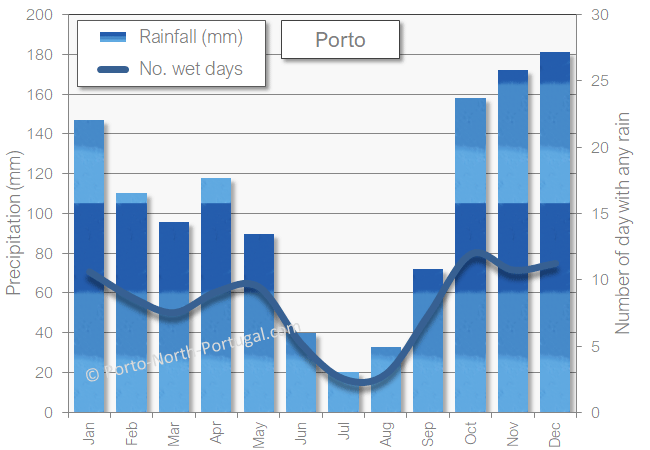
Insight: April is a surprisingly wet month in northern Portugal, with heavy rain brought on by seasonal winds. If you are planning a visit to Northern Portugal in spring, it is much better to delay the trip until mid-May or visit the much drier Algarve region instead.
The Best Time of Year to Visit Porto
For the ideal combination of fantastic weather and manageable crowds, the best time to visit Porto is during the shoulder seasons of late spring (May to June) and early autumn (September).
Within this perfect travel window, June stands out as the single best month to be in the city. The weather is reliably warm and sunny, ideal for sightseeing, yet the intense heat of mid-summer has not yet arrived. More importantly, June is when Porto celebrates the Festas dos Santos Populares, culminating in the spectacular Festa de São João on the night of the 23rd. This period offers a unique opportunity to see the city at its most vibrant and decorated.
Alternatively, September offers a brilliant travel window. You will experience the same wonderful weather as early summer but with a more relaxed, end-of-season atmosphere.
Ultimately, both periods provide the benefits of summer weather without the peak-season drawbacks of extreme crowds and inflated prices, offering the perfect balance for your trip.
Is Porto a Year-Round Destination?
The surge in Porto's popularity has extended its tourist season, with visitors now arriving through most of the year. Despite this trend, it is a mistake to classify Porto as a true year-round destination. Crucially, it should never be considered a location for a winter-sun holiday.
While the city's winter weather is a significant improvement over conditions in Northern Europe, the reality is a high probability of persistent rain. The key to a successful winter trip is flexibility. It is essential to have plans that can be easily adjusted to account for wet days, allowing you to make the most of the dry spells.
That said, Porto will have significantly better winter weather than most European cities and will be much warmer than Northern Europe. If you visit during the winter, it is best to have flexible plans which could account for the wet weather.
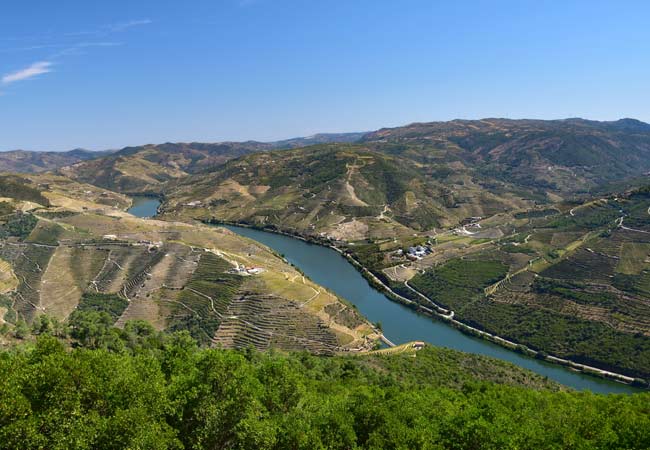
The large volume of winter rain feeds the mighty Douro River,
Securing Your Accommodation
During the peak summer months, the demand for accommodation in Porto is exceptionally high and frequently exceeds supply.
This results in the best-located and highest-rated hotels being fully booked months in advance. To secure the best prices and your preferred accommodation, booking as far in advance as possible is essential for a summer visit.
You can check current availability and prices by entering your holiday dates into the map below.
Booking.comChoosing the Right Portuguese Region for the Season
Before settling on the perfect time for your Porto trip, it's helpful to understand how the city compares to Portugal's other main destinations. The best region to visit often depends heavily on the season, and making the right choice can define your entire holiday.
Portugal has three main regions for a holiday; Porto, Lisbon, and the Algarve, and each offers a distinctly different experience. As a general rule, the country's climate gets warmer and drier the further south you travel. Porto, in the north, is often the most pleasant during the hot summers but is cooler and significantly wetter in winter than both Lisbon and the Algarve.
Of the three, Porto is the best destination during the peak summer months. It provides a welcome alternative to Lisbon's intense urban crowds and the Algarve's reliance on package-holiday tourism.
While both Porto and Lisbon offer rich culture, fascinating tourist attractions, and excellent nearby beaches, they possess unique characters. Lisbon, as the nation's sprawling capital, has a grander, more cosmopolitan feel that can be hectic for some visitors. Porto is more compact, with an authentic charm woven tightly along the steep banks of the Douro River. For a city break, the choice between them often comes down to a personal preference for scale and atmosphere.
The Algarve is firmly focused on beaches and resort towns; its cities do not offer the same depth or diversity as Porto or Lisbon. For a culture-rich city break in Portugal, your choice should always be between Lisbon and Porto.
Insight: Both Lisbon and Porto are surrounded by many beautiful beaches, and in the summer there is no need to head to Algarve for a beach holiday.
Related articles: Porto’s beaches - Lisbon guide - The Algarve
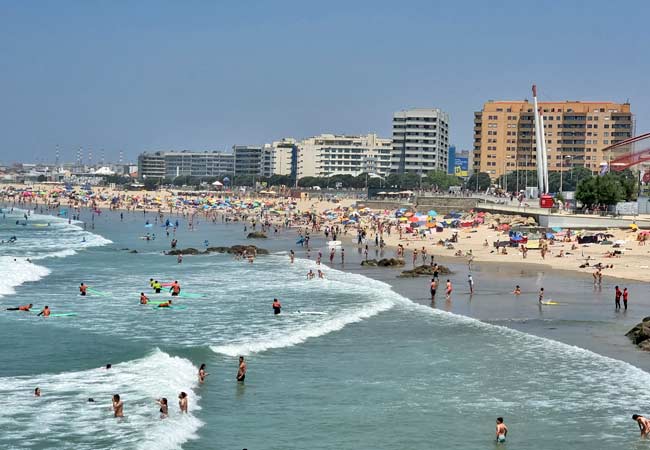
Praia de Matosinhos is popular with the Portuguese
The Surprisingly Cold Atlantic Waters
One of the biggest surprises for visitors to Porto's magnificent coastline is the temperature of the sea. Despite the hot summer weather, the ocean water remains consistently cold throughout the year.
Even at the height of summer in July and August, the sea temperature only reaches a brisk 18°C (64°F). In the winter, this drops to a chilly 14°C (57°F). This is a direct consequence of the Atlantic Ocean; the waters along the Costa Verde are fed by the cold Canary Current, which flows south along the Portuguese coast.
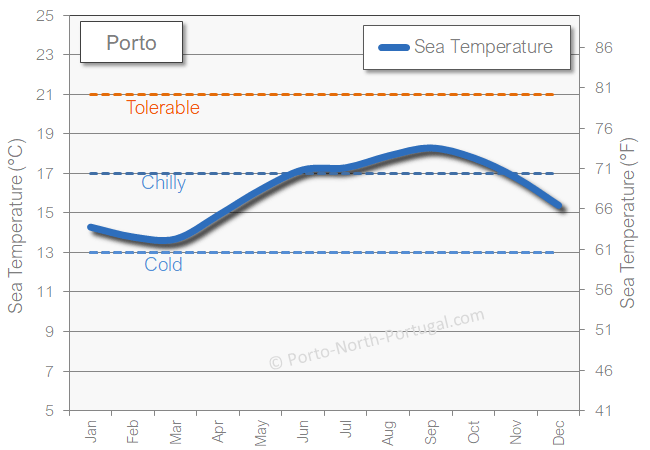
The Worst Month to Visit Porto
While every season has its appeal, January is the most challenging month for a trip to Porto and should generally be avoided if you have a choice.
January sits at the heart of Porto's wet and unpredictable winter. It typically experiences the highest levels of rainfall and the fewest hours of daily sunshine (averaging just 4.0 hours). The weather is often characterised by persistent dampness and grey skies, with a high probability of heavy downpours that can disrupt sightseeing plans and make exploring the city’s steep streets less enjoyable.
However, for budget-conscious travellers who do not mind the weather, January does have two clear advantages: it is the cheapest month to visit, and the city's attractions are at their quietest. If your vision for a trip involves cosy indoor activities and seeing landmarks without any queues, then a winter visit might work for you. But for the vast majority of visitors, January's weather makes it the least appealing time of year.
A Season-by-Season Guide to Porto
The Peak Season: July and August
This is when Porto is at its most energetic and crowded. The city buzzes with a vibrant, holiday atmosphere under the reliable summer sun.
• Weather: Expect hot and dry conditions. Daytime highs typically range from 25°C to 28°C (77-82°F), though temperatures can climb higher during a heatwave. Evenings remain pleasantly warm, rarely dropping below 16°C (61°F). The proximity to the Atlantic provides a welcome breeze, which moderates the most intense heat.
• Visitor Levels: Expect the city to be packed. Key attractions like the Livraria Lello, the Clérigos Tower, and the Port cellars in Vila Nova de Gaia will have long queues. Restaurants in the Ribeira district will be busy, and booking ahead for dinner is recommended.
• Experience: This is the time for a classic summer holiday. The pace is leisurely, with hot afternoons best spent on the beaches of Foz do Douro or Matosinhos. The downside is that demand for flights and hotels is at its absolute peak. To avoid inflated prices and limited availability, booking far in advance is not a suggestion; it is essential.
The Mid-Season: May, June, and September
For many, this is the perfect time to visit Porto, offering the ideal balance of wonderful weather and more manageable visitor numbers.
• Weather: The weather is glorious. Daytime temperatures are very pleasant, typically ranging from 20°C to 25°C (68-77°F), with plenty of sunshine. While an occasional shower is possible, especially in May, the weather is generally stable and perfect for being outdoors.
• Visitor Levels: The city is busy and has a lively atmosphere, but it is noticeably less crowded than in July and August. You will find more space at major sights and a more relaxed feel throughout the city.
• Experience: The comfortable weather makes this the ideal time for extensive sightseeing and exploration. This is the best season for taking day trips to regional cities like Braga, Guimarães, and Aveiro, or for embarking on a longer touring holiday of northern Portugal.
Insight: Be aware that October is a transitional month. The first half can be beautiful, with warm, sunny days continuing from September. However, the second half of the month often sees the return of the winter rains and can be very wet.
The Low Season: October to April
The low season offers a chance to see a more authentic side of Porto without the crowds, but it requires flexibility and preparation for rain.
• Weather: This period is defined by cooler, unpredictable, and often wet weather. Expect daytime highs of 13°C to 16°C (55-61°F) and cooler nights dropping to 5°C to 8°C (41-46°F). Rain is a frequent feature, and you should always be prepared for a downpour.
• Visitor Levels: Visitor numbers are at their lowest, especially from January to March. You will have major attractions almost to yourself and can experience the city at its most peaceful.
• Experience: One key advantage of Porto is that it is a major working city, so unlike the resort towns of the Algarve, everything remains open year-round. The low season is perfect for a spontaneous weekend break. By monitoring the forecast a week ahead, you can book an inexpensive trip to coincide with a dry spell and enjoy the city's atmospheric charm.
If you've enjoyed our content, we'd like to ask for your support.
The internet landscape has changed, and small independent publishers like us face increasing challenges. Search engines now prioritize advertising over organic content, reducing our traffic, while AI systems increasingly copy our original work without attribution.
To help support us, please consider bookmarking our website for easy access. If you find an article useful, we encourage you to share it with friends or on social media. Equally, if you notice anything outdated or incorrect, please let us know so we can promptly address it.
We're always open to collaborating with brands, bloggers, and SEO/PR agencies who value independent creators. If you'd like to work with us or offer support, please reach out at: [email protected]
Thank you for being part of our community and helping us continue to provide valuable content in an increasingly challenging digital environment.

























